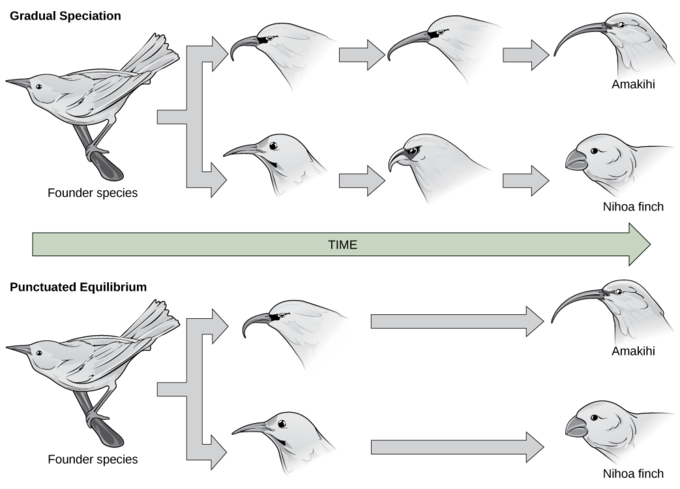2.3.3: Rates of Speciation and Extinction
- Page ID
- 108055
\( \newcommand{\vecs}[1]{\overset { \scriptstyle \rightharpoonup} {\mathbf{#1}} } \)
\( \newcommand{\vecd}[1]{\overset{-\!-\!\rightharpoonup}{\vphantom{a}\smash {#1}}} \)
\( \newcommand{\id}{\mathrm{id}}\) \( \newcommand{\Span}{\mathrm{span}}\)
( \newcommand{\kernel}{\mathrm{null}\,}\) \( \newcommand{\range}{\mathrm{range}\,}\)
\( \newcommand{\RealPart}{\mathrm{Re}}\) \( \newcommand{\ImaginaryPart}{\mathrm{Im}}\)
\( \newcommand{\Argument}{\mathrm{Arg}}\) \( \newcommand{\norm}[1]{\| #1 \|}\)
\( \newcommand{\inner}[2]{\langle #1, #2 \rangle}\)
\( \newcommand{\Span}{\mathrm{span}}\)
\( \newcommand{\id}{\mathrm{id}}\)
\( \newcommand{\Span}{\mathrm{span}}\)
\( \newcommand{\kernel}{\mathrm{null}\,}\)
\( \newcommand{\range}{\mathrm{range}\,}\)
\( \newcommand{\RealPart}{\mathrm{Re}}\)
\( \newcommand{\ImaginaryPart}{\mathrm{Im}}\)
\( \newcommand{\Argument}{\mathrm{Arg}}\)
\( \newcommand{\norm}[1]{\| #1 \|}\)
\( \newcommand{\inner}[2]{\langle #1, #2 \rangle}\)
\( \newcommand{\Span}{\mathrm{span}}\) \( \newcommand{\AA}{\unicode[.8,0]{x212B}}\)
\( \newcommand{\vectorA}[1]{\vec{#1}} % arrow\)
\( \newcommand{\vectorAt}[1]{\vec{\text{#1}}} % arrow\)
\( \newcommand{\vectorB}[1]{\overset { \scriptstyle \rightharpoonup} {\mathbf{#1}} } \)
\( \newcommand{\vectorC}[1]{\textbf{#1}} \)
\( \newcommand{\vectorD}[1]{\overrightarrow{#1}} \)
\( \newcommand{\vectorDt}[1]{\overrightarrow{\text{#1}}} \)
\( \newcommand{\vectE}[1]{\overset{-\!-\!\rightharpoonup}{\vphantom{a}\smash{\mathbf {#1}}}} \)
\( \newcommand{\vecs}[1]{\overset { \scriptstyle \rightharpoonup} {\mathbf{#1}} } \)
\( \newcommand{\vecd}[1]{\overset{-\!-\!\rightharpoonup}{\vphantom{a}\smash {#1}}} \)
Unit 2.3.3 - Rates of Speciation and Extinction
- Please read and watch the following Mandatory Resources
- Reading the material for understanding, and taking notes during videos, will take approximately 30 minutes.
- Optional Activities are embedded.
- Bolded terms are located at the end of the unit in the Glossary. There is also a Unit Summary at the end of the Unit.
- To navigate to Unit 2.4, use the Contents menu at the top of the page OR the right arrow on the side of the page.
- If on a mobile device, use the Contents menu at the top of the page OR the links at the bottom of the page.
- Explain how the interaction of an organism’s population size in association with environmental changes can lead to different rates of speciation
Introduction - Varying Rates of Speciation
Scientists around the world study speciation, documenting observations both of living organisms and those found in the fossil record. As their ideas take shape and as research reveals new details about how life evolves, they develop models to help explain rates of speciation. In terms of how quickly speciation occurs, two patterns are currently observed: the gradual speciation model and the punctuated equilibrium model.
In the gradual speciation model, species diverge gradually over time in small steps (Figure \(\PageIndex{1}\)). In the punctuated equilibrium model, a new species changes quickly from the parent species and then remains largely unchanged for long periods of time afterward. This early change model is called punctuated equilibrium, because it begins with a punctuated or periodic change and then remains in balance afterward. While punctuated equilibrium suggests a faster tempo, it does not necessarily exclude gradualism.

The primary influencing factor on changes in speciation rate is environmental conditions. Under some conditions, selection occurs quickly or radically. Consider a species of snails that had been living with the same basic form for many thousands of years. Their fossils would appear similar for a long time. When a change in the environment takes place, such as a drop in the water level, a small number of organisms are separated from the rest in a brief period of time, essentially forming one large and one tiny population. The tiny population faces new environmental conditions. Because its gene pool quickly became so small, any variation that aids in surviving the new conditions becomes the predominant form. More on speciation (and extinction) is discussed in Unit 3.3.1.
Which of the following statements is false?
- Punctuated equilibrium is most likely to occur in a small population that experiences a rapid change in its environment.
- Punctuated equilibrium is most likely to occur in a large population that lives in a stable climate.
- Gradual speciation is most likely to occur in species that live in a stable climate.
- Gradual speciation and punctuated equilibrium both result in the divergence of species.
- Answer
-
B. Punctuated equilibrium is most likely to occur in a large population that lives in a stable climate.
Evolutionary biologist Stephen J. Gould used the formations of the Burgess Shales, between Golden, British Columbia and Banff, Alberta, to support his hypothesis of the punctuated equilibrium model. The Burgess Shales are one of the foremost places in the world to study the fossils of the Cambrian Explosion of life from 550 million years ago.
The Burgess Shales foundation website: https://www.burgess-shale.bc.ca/the-cambrian-explosion-and-the-burgess-shale/
American Museum of Natural History website on Burgess Shales: https://www.amnh.org/research/paleontology/collections/fossil-invertebrate-collection/trilobite-website/niles-eldredge-trilobites-punctuated-equilibria
Canadian Encyclopedia entry on Burgess Shales: https://www.thecanadianencyclopedia.ca/en/article/burgess-shale-fossils


